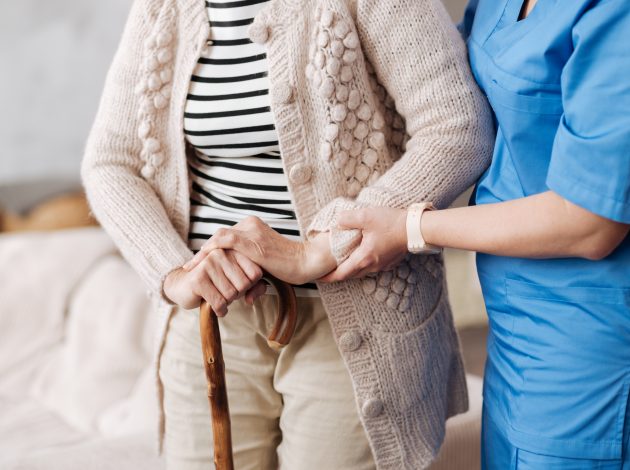As the Coronavirus pandemic has developed, carers and those receiving care have been significantly affected. The ONS has undertaken several pieces of analysis looking at the impact on social care patients, care staff and those with caring responsibilities. Sophie John examines the overall picture of findings so far.
The impact on those working in the care sector
Health and social care workers are the largest proportion of key worker occupations, making up 31% of these roles while 15% of key workers are identified to be at moderate risk from COVID-19, mostly due to certain health conditions such as asthma, heart disease and diabetes. Using the Coronavirus infection survey, we found that people working in patient-facing roles like NHS professionals and nursing home or care home workers had a higher positive COVID-19 test rate (1.58%) than those who work in non-patient facing roles (0.27% tested positive).
The nature of these roles, where staff are in close contact with patients and other employees, may result in them being more likely to come into contact with someone who has COVID-19. To explore this we have reported on elevated death rates involving coronavirus for male and female social care workers.
Additionally, the health and social work industry have, understandably, the highest levels of staff continuing to work at their normal place of work, rather than remotely. The Business Impact of COVID-19 survey (wave 5) revealed that people who worked in this industry also had the highest proportion of increased working hours when compared to other industries. Furthermore, it has been reported that more key workers (12%) than non-key workers (10%) have caring responsibilities.
In a survey of more than 9,000 care homes providing support for dementia patients and older people in England, more than half (56%) of the care homes that responded had at least one confirmed case of coronavirus, as reported by care home managers. Across those care homes where managers reported at least one case of coronavirus, 7% of staff are estimated to have tested positive for COVID-19 since the start of the pandemic. Care homes using bank or agency nurses or carers regularly, are more likely to have cases in staff and residents compared to those care homes who never use bank or agency staff. Care homes where staff regularly work elsewhere are more likely to have more cases in staff than those who have staff who never work elsewhere. Finally, care homes in which staff receive sick pay are less likely to have cases of COVID-19 in residents compared to those care homes where staff do not receive sick pay.
What about care home residents?
Since the beginning of the pandemic nearly 30% of all care home resident deaths in England and Wales were deaths involving COVID-19. Total care home resident deaths currently (19,394) make up 40% of all COVID-19 related deaths. Of the deaths involving COVID-19 in care home residents almost three quarters (74.9%) occurred within the care home.
The Care Quality Commission (CQC) also collect information on recipients of domiciliary care in England; that is care provided in a private home by a home care agency registered with CQC. From 10 April 2020 (when data are first available) to 19 June 2020, there were 6,523 deaths of recipients of domiciliary care in England, which is almost double the three-year average. Of these 12.6% involved COVID-19 which is lower than the levels of COVID-19 in those living in care homes.
Looking at infection, of the 56% of care homes that reported having at least one confirmed case of coronavirus, 20% of residents are estimated to have tested positive for Covid-19 since the start of the pandemic.
What has been the impact on caring responsibilities?
The social isolation measures introduced to reduce COVID-19 transmission, whilst essential, may have adversely affected the well-being of care receivers and providers. A common concern throughout the pandemic was that people’s access to paid or unpaid care was affected while others expressed concerns regarding their household finances due to care costs increasing.
Some people have reported that their caring responsibilities have been affected by COVID-19, with the majority spending more time caring for others. One third (33%) of carers mentioned giving more help during the pandemic than they had provided previously. Almost one third (32%) also mentioned giving help to someone who they did not help previously.
Since the pandemic, 48% of the UK population said they provided support to someone outside of the household. Although not directly comparable, 11% of people reported caring for a non-resident, before the pandemic.
In some cases, carers have reported being unable to see someone they usually would provide support for or having to organise alternate care where paid care has been reduced. Over 80% of people said that they had avoided physical contact with older and vulnerable people due to COVID-19 and some have had to avoid physical contact with those they have care responsibilities for.
Unpaid carers, who provide support to someone they live with, are most likely to mention feeling worried about the future (36%), with 32% reporting feeling stressed and 16% concerned about the effect the pandemic has had on their personal relationships.
What’s next?
Over the coming months, the ONS will continue to provide insight into the impact COVID-19 is having on the care sector which will be published on our dedicated COVID-19 page with edited highlights in our COVID-19 round up.
Dr. Sophie John, Adult Social Care, Health Analysis and Life Events
